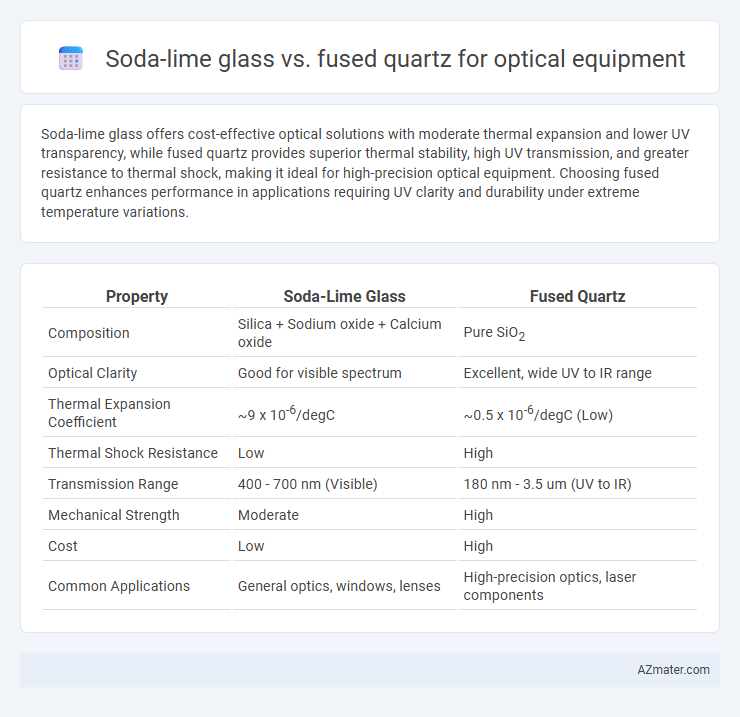Soda-lime glass offers cost-effective optical solutions with moderate thermal expansion and lower UV transparency, while fused quartz provides superior thermal stability, high UV transmission, and greater resistance to thermal shock, making it ideal for high-precision optical equipment. Choosing fused quartz enhances performance in applications requiring UV clarity and durability under extreme temperature variations.
Table of Comparison
| Property | Soda-Lime Glass | Fused Quartz |
|---|---|---|
| Composition | Silica + Sodium oxide + Calcium oxide | Pure SiO2 |
| Optical Clarity | Good for visible spectrum | Excellent, wide UV to IR range |
| Thermal Expansion Coefficient | ~9 x 10-6/degC | ~0.5 x 10-6/degC (Low) |
| Thermal Shock Resistance | Low | High |
| Transmission Range | 400 - 700 nm (Visible) | 180 nm - 3.5 um (UV to IR) |
| Mechanical Strength | Moderate | High |
| Cost | Low | High |
| Common Applications | General optics, windows, lenses | High-precision optics, laser components |
Introduction to Optical Glass Materials
Soda-lime glass, composed primarily of silica, sodium oxide, and calcium oxide, offers cost-effective optical properties with moderate refractive index and dispersion suitable for general optical applications. Fused quartz, made from nearly pure silicon dioxide, provides superior optical clarity, high thermal stability, and low thermal expansion, essential for precision optical equipment exposed to extreme environments. The selection between soda-lime glass and fused quartz depends on performance requirements such as wavelength transmission range, thermal resistance, and mechanical durability.
Overview of Soda-lime Glass
Soda-lime glass, primarily composed of silica, sodium oxide, and calcium oxide, is widely used in optical equipment due to its affordability and ease of fabrication. It offers moderate optical clarity, good chemical durability, and thermal stability but has a lower melting point and higher thermal expansion compared to fused quartz. These properties make soda-lime glass suitable for applications where cost efficiency is prioritized over extreme thermal resistance and high optical performance.
Overview of Fused Quartz
Fused quartz is a high-purity silica glass known for its exceptional optical clarity, low thermal expansion, and superior resistance to thermal shock, making it ideal for precision optical equipment. Unlike soda-lime glass, fused quartz offers excellent transmission in ultraviolet and infrared wavelengths, supporting applications in UV optics and laser systems. Its chemical durability and mechanical strength contribute to long-term stability and performance in demanding optical environments.
Optical Properties Comparison
Soda-lime glass exhibits moderate optical clarity with a refractive index around 1.52 and relatively high dispersion, leading to noticeable chromatic aberration in optical equipment. Fused quartz offers superior optical properties, including a refractive index near 1.46, exceptional transparency from ultraviolet to infrared wavelengths, and minimal chromatic dispersion, making it ideal for precision optics. The high transmission and low thermal expansion of fused quartz significantly enhance image quality and stability compared to soda-lime glass in demanding optical applications.
Thermal Stability and Expansion
Fused quartz exhibits superior thermal stability compared to soda-lime glass, maintaining optical clarity and structural integrity at temperatures exceeding 1,000degC, while soda-lime glass typically softens around 600degC. The coefficient of thermal expansion (CTE) for fused quartz is approximately 0.55 x 10-6/degC, significantly lower than soda-lime glass's CTE of about 9 x 10-6/degC, reducing thermal distortion and stress in precision optical applications. This low thermal expansion and high resistance to thermal shock make fused quartz the preferred material for high-performance optical equipment operating under extreme temperature variations.
Transmission Range and UV Performance
Soda-lime glass typically offers a transmission range from about 350 nm to 2,500 nm but suffers from poor UV transmission below 350 nm, limiting its effectiveness for deep UV optical applications. Fused quartz excels with a much broader transmission range, spanning approximately 185 nm to 3,500 nm, and demonstrates superior UV performance due to its low absorption and high damage threshold in the UV spectrum. This makes fused quartz the preferred material for high-precision optical equipment requiring excellent UV transparency and durability.
Mechanical Strength and Durability
Soda-lime glass offers moderate mechanical strength and cost-effectiveness but exhibits lower durability and higher susceptibility to thermal shock compared to fused quartz. Fused quartz provides superior mechanical strength with excellent resistance to thermal expansion and chemical corrosion, making it ideal for demanding optical equipment applications. Its exceptional durability ensures long-term performance in harsh environmental conditions.
Cost and Manufacturing Considerations
Soda-lime glass is significantly more cost-effective than fused quartz, making it a preferred choice for budget-sensitive optical equipment applications. Manufacturing soda-lime glass is simpler and faster due to its lower melting point and widespread availability of raw materials, whereas fused quartz requires higher temperatures and more complex processing, increasing production time and expenses. Despite its higher cost, fused quartz offers superior thermal stability and optical clarity, justifying its use in high-precision or high-temperature optical devices.
Suitability for Specific Optical Applications
Soda-lime glass is ideal for general optical applications requiring cost-effective and durable materials, such as standard lenses, windows, and display screens, due to its moderate thermal and mechanical properties. Fused quartz excels in high-precision optical equipment like UV lithography lenses, laser systems, and high-temperature environments, offering superior optical clarity, low thermal expansion, and excellent resistance to thermal shock. Selection depends on the application's wavelength range, thermal demands, and precision requirements, with fused quartz preferred for UV and high-purity optical performance.
Conclusion: Choosing the Right Material
Soda-lime glass offers cost-effective optical clarity suitable for general applications, while fused quartz provides superior thermal stability, UV transparency, and resistance to thermal shock, making it ideal for high-precision and high-temperature environments. Selecting fused quartz ensures enhanced durability and performance in demanding optical systems such as laser equipment and UV optics. Opt for soda-lime glass for budget-sensitive projects with moderate requirements, but choose fused quartz to achieve optimal reliability and advanced optical properties.

Infographic: Soda-lime glass vs Fused quartz for Optical equipment
 azmater.com
azmater.com